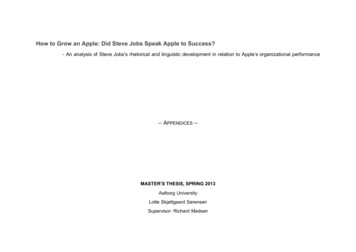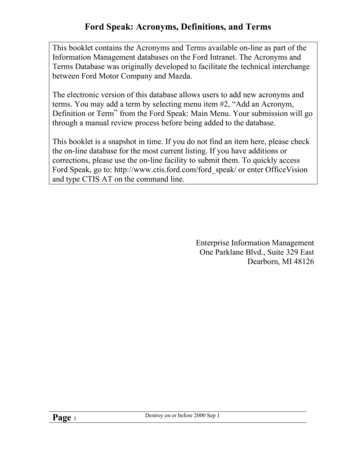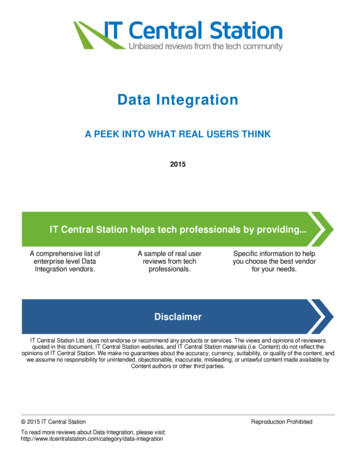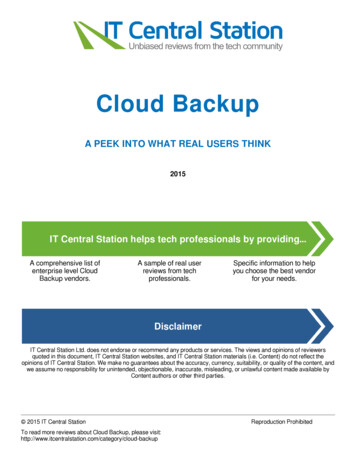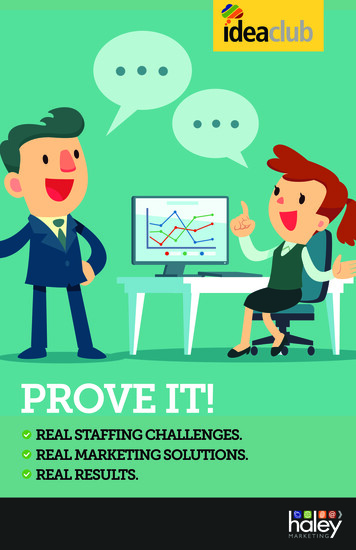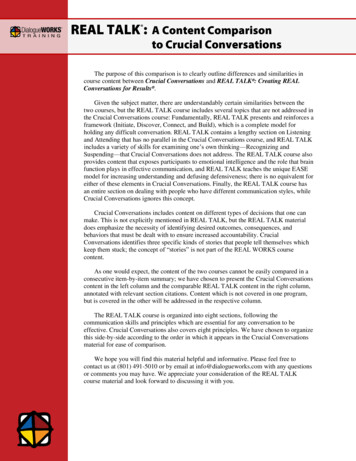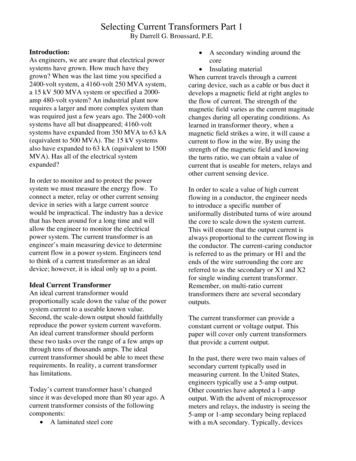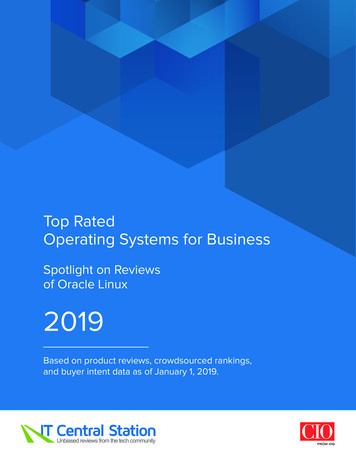
Transcription
REAL USERS SPEAK: SELECTING THE RIGHTSOFTWARE SECURITY TESTING TOOLPeerPaper ReportTop RatedSpotlighton Reviews ofOperating Systems for Business2018Spotlight on Reviewsof Oracle Linux2019Based on real user experiencesBased on product reviews, crowdsourced rankings,and buyer intent data as of January 1, 2019.Copyright 201 IT Central Station
About This ReportGuide to RankingsTotal # of Reviews on IT Central StationWeighting Factor 17.5%45.92#136 (20 Reviews)27.91 (8.7 Average Rating)QlikView93.83 Total PointsBuyer Intent IndexAvg Rating Based on ReviewsWeighting Factor 52.5%Weighting Factor 30%The total ranking of a product, represented by the bar length, is based on a weighted aggregate score. The score is calculated as follows: The product with the highestcount in each area gets the highest available score. (20 points for Reviews; 48 points for Buyer Intent Index.) Every other product gets assigned points based on its totalin proportion to the #1 product in that area. For example, if a product has 80% of the number of reviews compared to the product with the most reviews then the product’sscore for reviews would be 20% (weighting factor) * 80% 16. For Average Rating, the maximum score is 32 points awarded linearly based on our rating scale of 1-10. If aproduct has fewer than ten reviews, the point contribution for Average Rating is reduced (one-third reduction in points for products with 5-9 reviews; two-thirds reduction forproducts with fewer than fve reviews). Reviews that are more than 24 months old, as well as those written by resellers, are completely excluded from the ranking algorithm.About UsUser reviews, candid discussions, and more for enterprisetechnology professionals.The Internet has completely changed the way we make buyingdecisions. We now use ratings and review sites to see what other realusers think before we buy electronics, book a hotel, visit a doctor orchoose a restaurant. But in the world of enterprise technology, mostof the information online and in your inbox comes from vendors butwhat you really want is objective information from other users. ITCentral Station provides technology professionals with a communityplatform to share information about enterprise solutions.IT Central Station is committed to ofering user-contributed informationthat is valuable, objective and relevant. We validate all reviewerswith a triple authentication process, and protect your privacy byproviding an environment where you can post anonymously andfreely express your views. As a result, the community becomes avaluable resource, ensuring you get access to the right informationand connect to the right people, whenever you need it.IDG Enterprise, an International Data Group (IDG) division, bringstogether the leading B2B editorial brands (CIO, Computerworld, CSO,InfoWorld and Network World) to serve the information needs of ourtechnology- and security-focused audiences.As the leading enterprise technology media, data and servicescompany, IDG Enterprise unites the enterprise technology ecosystem.We leverage the strengths of our premium brands, while alsoharnessing their collective reach and audience afnity. We provideconverged marketing solutions for tech marketers to engage ITand security decision-makers across our portfolio of award-winningwebsites, events, digital magazines, products and services. IDG’sInsider program ofers premium content (such as reviews, research,guides and interviews) for registered IT buyers.Company information is available athttp://www.idgenterprise.comIDG is the world’s leading technology media, events and researchcompany, reaching 280 million technology buyers in 97 countries.IT Central Station does not endorse or recommend any productsor services. The views and opinions of reviewers quoted in thisdocument, IT Central Station websites, and IT Central Stationmaterials do not refect the opinions of IT Central entralstation.comIT Central Station Ltd. does not endorse or recommend any products or services. The views and opinions of reviewers quoted in this document, IT Central Station websites, and IT CentralStation materials (i.e. Content) do not refect the opinions of IT Central Station. We make no guarantees about the accuracy, currency, suitability, or quality of the content, and we assume noresponsibility for unintended, objectionable, inaccurate, misleading, or unlawful content made available by Content authors or other third parties. 2019, IT Central Station
Top Rated Operating Systems for BusinessPoints KeyBuyer Intent IndexAverage RatingReviewsAccess all reviews at ing-systems-for-business45.92#193.83 Total Points3.33 (6 Reviews)19.21 (9.0 Average Rating)RHEL59.83 Total Points3.89 (7 Reviews)19.21 (9.0 Average Rating)Oracle Solaris49.75 Total Points22.51#527.93 (8.7 Average Rating)61.37 Total Points26.65#46.11 (11 Reviews)Ubuntu Linux37.29#327.91 (8.7 Average Rating)Oracle Linux27.33#236 (20 Reviews)3.89 (7 Reviews)18.14 (8.5 Average Rating)CentOS44.54 Total Points 2019, IT Central Station
Real User Review ofOracle LinuxSee All ReviewsKsplice Allows Us To ApplyHot-Patching Without DowntimeAnd Avoid Scheduling IssuesAcross Multiple OrganizationsABOUT THE REVIEWERIan LeathCTO EMEIA at FujitsuPrimary Use CaseFujitsu’s Oracle/Intel platform has been specifcally designed with Oracle in mind using Oracle VM, Oracle Linux,for our customers wanting to use Oracle product, applications, databases. We’ve designed it in a way that weget the best possible performance from the applications and databases on our engineered system.Improvements to My OrganizationWhat it’s allowed us to do, initially, it allowed us to develop an Intel platform specifcally for Oracle. What’s mostimportant for us, where it comes across is the licensing. It’s very difcult - sometimes you can build a platformthat is optimal, but when you apply Oracle licenses across that platform, it isn’t the most economical. All of ourIntel platform for this has been optimized towards which Oracle solutions are going to be running on it, to getboth the best performance but also that will be economical for our customers.Because it’s specifcally built for Oracle, with Oracle applications and solutions in mind, we have standardpricing, a standard way of working, a standard cost for each organization. That allows us to save time, on bothbid and, once new requirements come along for each organization, we know exactly what it takes to add tothat solution, to add to that platform. The saving for us is, we can feed back quickly to grow, respond to newrequirements.Valuable FeaturesWith Oracle Linux Ksplice specifcally, we have organizations looking for minimum downtime. We’re able toapply hot-patching at any time; once we’ve proven they’re tested, ready to go, we don’t need to take downtimeto apply them.We have a shared services platform with multiple organizations set on it. So planning downtime across all thoseorganizations becomes more and more difcult. The more organizations we get onto the platform, the less“white space” is available. Ksplice allows us to do hot-patching without the downtime. That, for us, is quite key.Also, the virtualization, Oracle VM, allows us to get the best performance for our Oracle applications anddatabase solutions. We know it’s proven to be more performant with Oracle applications, so we get the bestperformance out of it on our platform. 2019, IT Central Station
Room for ImprovementScalability IssuesWhat we found in moving from Oracle Linux 6to Oracle Linux 7 was the whole interfacing withthe application and the fact that operating had allchanged, all the commands had changed. You needto be aware that there is some kind of training,some kind of handover required for your technicalguys, understanding diferent ways of interactingwith it. Bear that in mind.We have a use case of a shared platform wherewe have one large organization set on our Intelplatform. The virtualization then allows us to growout for when we get more and more organizationson.Stability IssuesWe’ve just added another huge organization, DHL,they are now set on that shared platform alongwith another organization. That hasn’t impactedit in the least. We are able to scale out and scalewith that organization. That organization itself, thatspecifc program, could grow and grow. So it allowsus that fexibility to grow that whichever way. If thatorganization’s business case grows and becomesbigger and bigger, the platform can scale out to that.What we experienced is, the stability is key. Whatwe can’t take into account with customers is howthey’re going to want to use the platform, oncewe’ve installed it, once we’ve got diferent solutionsrunning on that platform.It also allows us to add in more organizations onthe same platform with one overview of managing.For us, as an organization we can manage it froma single point with multiple organizations using it,with no impact on each other.Use of SolutionMore than fve years. 2019, IT Central Station
Customer Service and TechnicalSupportWe don’t have any problems with Oracle technicalsupport. Our guys can normally resolve most of theissues themselves, but where we do require furtherhelp, we have direct contact with Oracle, and theturnaround is what we’d expect.Other SolutionsWe were driven to some part by how the cost oflicensing of Oracle databases and needed toensure the most cost efective way to do this, soreally OVM was the only option for us.Other AdviceI am the Oracle practice CTO. I work for Fujitsu.We cover all the aspects of IT, for enterprise, forinfrastructure, through to applications and managedservices. I work for the Business ApplicationsServices, we cover anything around enterprisesolutions, enterprise architecture, anything that willaid them in their business process. In my role atFujitsu I oversee all of the Oracle architects, so anysolution owners from infrastructure to applications,and all the bits in between. All architects andsolution owners report to me.In the context of, if you’re wanting to use the Oracleworkloads, absolutely, this is the way you need togo. For non-Oracle workloads, again, no problemswith that at all. From Fujitsu’s point of view, andwhere it sits on our Intel platform, this is a nobrainer. We specifcally built it with Oracle in mind.Therefore, using Oracle VM and Oracle Linux wasthe way forward.If that’s the way you’re going, if you’re looking touse Oracle applications, Oracle Databases, I woulddefnitely recommend using the OVM and OracleLinux.It performs perfectly for what we require it to do.There are, obviously, certain issues that havebeen highlighted in the next version. That’s notthe product itself, that’s just the usability of it. Wewould rate the Oracle OVM, the Oracle Linux, eightto nine out of 10.Disclosure: I am a real user, and this review is based onmy own experience and opinions.Download Oracle Linux 2019, IT Central Station
Real User Review ofOracle LinuxSee All ReviewsOut Of The Box It’s AlreadyPre-Optimized And Pre-Confgured.Having That Marriage Between TheOS And The Database Is Critical.ABOUT THE REVIEWERBert ScalzoSenior Product Manager at asoftware R&D company with10,001 employeesImprovements to My OrganizationPerformance and stability. I can get maximum performance with the least amount of efort, and stability-wise, Inever have a crash. I’ve yet to have one.Valuable FeaturesWhat I like about Oracle Linux is that out of the box it’s already pre-optimized, pre-confgured, has all the rightRPMs, has checking packages. It’s basically all the stuf I would have to do with a diferent distribution manually.It probably saves me a couple of hours on each time I do a database install, and that’s worth a lot. Plus, theperformance is better because it’s been highly optimized or tuned. The kernels been optimized. The memorymanagement specifcally is better, so it makes for a very stable platform.Room for ImprovementOne of them is because I’m lazy, and most people wouldn’t admit that, but when you go from version 6 toversion 7 of Linux, a lot of commands changed, and even some fle locations have changed. I wish they wouldkeep the compatibility mode, or the stupid mode for me for a couple of years. I hate to learn new commandsright away, but it is what it is.Just keeping up, keeping the pace with the Red Hat main distributions, so if Red Hat’s on 7.3, I’d like to seeEnterprise Linux on 7.3, at the same time. On one occasion, I think they actually beat Red Hat. I think they cameout with their point release frst. That’s what I would kind of like, is for them to stay very aggressive on that,because kernel modifcations typically end up being performance. They have taken the best of Solaris and putit into it. They keep adding tools that are necessary for doing performance optimization and monitoring. It’s verymature.Stability IssuesWhat’s really nice about the stability is that even when you have situations that might cause issues with otherOSs, other variants of Linux, Oracle Enterprise Linux seems to do a better job of catching and handling thoseexceptions. An example would be, maybe I’m doing a wrap-cluster or I’m using ASM, automatic storagemanagement, there are some cases where those products can cause an error that might cause a diferentdistribution of Linux to maybe hang or lock or get confused. With Enterprise Linux it seems to be a non-issue.It’s very stable. 2019, IT Central Station
Scalability IssuesI love the scalability. Because of the fact that it’salready optimized for performance, I can scale it towhatever maximum numbers I need very easily. Theonly time I have to make any adjustments is if I’mdoing RAC, real application clusters, I may want totune a little bit diferently based on the number ofnodes, but it’s very minimal.Customer Service and TechnicalSupportOracle technical support is like most companies withtechnical support. It’s either great or horrible. It sortof depends on the phone call. Generally speaking,it’s great. A lot of times though, if you’re in a missioncritical situation, you need to get them to escalateyou to level two so that you can get beyond the frstlevel and typically you can get an answer quicker.I would say the most interesting interaction I hadwith them was, one time I was patching an Exadatamachine and I did a step wrong because I didn’t readall the directions. Did an incorrect step. Ruined myExadata box. Made sure that they got me to secondlevel support, and then it took us about eight hoursworking together but we got it recovered. Very fewvendors would have spent eight hours, midnight toeight AM, just on a phone call.Previous SolutionsI was an early adopter of Linux, long beforecompanies saw the light, and before it wentmainstream. I would say I got into the early adopter,sort of experimental stage, so that I would beprepared when my companies were positioned totake advantage of it, I would already be an expert.I actually started using Linux, probably about thetime that Red Hat was Red Hat version 3, so morethan a decade ago, probably closer to 15 years,and part of that was because I could see that thecommoditization of hardware was going to meanthat server rooms were going to be predominantlyIntel, and they were going to predominantly beWindows and Linux, and you’d better know both ofthem. With Linux being a much lower cost OS, andalso hosting databases like Oracle really well, you 2019, IT Central Station
just knew it was going to end up in the Enterpriseenvironment, and it just made sense to work withEnterprise Linux. Now I worked originally with RedHat and CentOS, but it very clearly became evidentto me that Oracle Enterprise Linux, starting atversion 5.8, was just as good, just as stable, oferedmore with very few diferences in the learningcurve.Oracle does have a few additional tools that are noton the standard distribution, but they actually makeyour job a lot of easier, like for example, one ofthem is an RPM check. It just checks to make surewe have all of the pre-loaded or the pre-requiredRPMs loaded, and there’s nothing to do other thanto activate it, and it just gives you a message. It’snot very hard to learn these additional features.Other Solutions ConsideredThe marriage with the database, to me is the mostcritical or most important item. Now I know thatsounds like I may be pandering to Oracle, sincethey make the database and they make the OS, butit’s just a natural. The same as with Microsoft SQLServer. Why do you run it on Windows? Now, I knowit’s coming on Linux, but where will it probably runbest for a long time? Probably on Windows.Having that marriage between the OS and thedatabase is critical, and Oracle really understandstheir database, better than anybody else, and theyseem to understand Linux as well as anybody else,and they were an early contributor, so it’s just anatural progression to put the database on theirLinux.Other AdviceRating: It’s a 10, because even though there arefree alternatives, I mean totally free alternatives,like CentOS, I’ve quit using them. For me to quitusing something that’s totally free, with no evenmaintenance charges, must mean that what I’vechosen is worth every penny of whatever coststhere are. Oracle Linux is clearly there.Disclosure: IT Central Station contacted the reviewerto collect the review and to validate authenticity. Thereviewer was referred by the vendor, but the review isnot subject to editing or approval by the vendor.Download Oracle Linux 2019, IT Central Station
QlikView . 93.83. Total Points . Buyer Intent Index . Weighting Factor 52.5% . Avg Rating Based on Reviews . . We were driven to some part by how the cost of licensing of Oracle databases and needed to ensure the most cost efective
